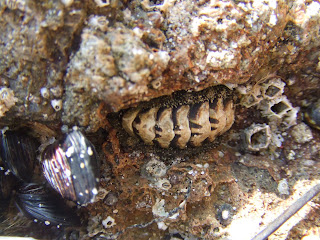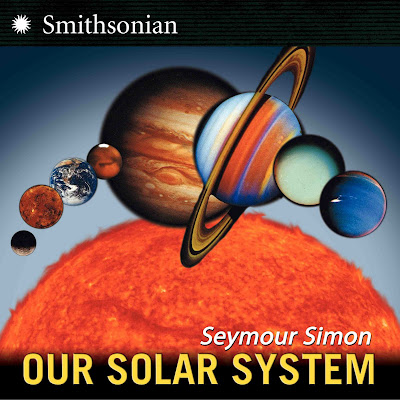April 2, 2010
Empowering Mommy: Global Warming by Seymour Simon
Posted by: Liz Nealon





April 1, 2010

Eco-Libris blog: Green book of the week: Global Warming by Seymour Simon
Posted by: Seymour Simon





April 1, 2010
The top image shows mostly mussels, the middle image are barnacles and the third image is a chiton.

A mussel is a kind of bivalve mollusk similar to a clam (that a lot of people like steamed with a bit of garlic and oil atop a heap of linguine).
Barnacles are a completely different kind of animal, more closely related to crabs and lobster than to clams and mussels. They are not all that tasty and rarely end up in a plate of spaghetti.
Both mussels and barnacles (and chitons as well) attach themselves to rocky surfaces in the tidal zone where they are covered by the sea at high tide and exposed to the air at low tide. They also attach themselves to boats left in the water and to piers and docks. 
Chitons are mollusks with eight overlapping shells (count them), more closely related to mussels and clams than to barnacles.
Posted by: Seymour Simon
March 31, 2010

I was looking at the moon two nights ago when I decided that I might be able to take a photo of the moon with my new digital camera that has a magnification of about ten times. This is a hand-held photo and I’m just amazed at how clear it is. Why don’t you try to take a photo of the moon yourself with a digital camera? It would be best if you can to increase the ASA speed to 800 or more (ask someone to help if you don’t know how to do this). Also prop the camera on something solid and hold it as steadily as you can. You may have to do a bit of editing to crop the moon to fill the whole frame but it’s easier than you think. In fact, here’s a contest: Best shot of the moon that I get by the end of April gets a brand new signed copy of my book THE MOON.
Posted by: Seymour Simon





March 29, 2010
Liz and I have been walking every morning on Carbon Beach here in Malibu, and the action of the surf here is quite extraordinary. Huge piles of rocks appear and then disappear on the beach - often a complete change from one day to the next.
This is a shot of the beach on Saturday morning. There are a few, small rocks laying around, but it’s mostly sand.
Here is the exact same spot, on Sunday afternoon - note the huge pile of rocks!

And these aren’t little rocks!
We’ve asked many locals why this happens, and they just shrug and say "the tides." I guess, as year-round dwellers, they are used to this action. I have walked many beaches in my day, and I have never seen this kind of phenomenon. It certainly makes you aware of the powerful pull of the moon’s gravity, creating tides that move rocks with this kind of force! Certainly waves, which are created by the strength and "fetch" of the winds, are also responsible for the coming and going of the rock piles on the shore.
Just this morning when we walked on the beach, we saw that all the rock piles had disappeared again! I guess we need my fictional character Einstein Anderson to solve this mystery. I am, however, open to any non-fictional characters who want to explain this to me in more detail. Anyone?
Posted by: Seymour Simon
March 26, 2010

Hi my name is Spencer G. and I am doing a research project for school. I told my mom I wanted to interview you for my ‘Origins of the Sun’ project. I could not believe it when she told me she had gotten in touch with you and to leve my questions here for you!
1. What role did the sun play in the formation of the Milkyway?
2. What role did the planets play in the formation of the sun?
3. What role diddid the sun play in the formation of the planets?
4. What role did the stars, (other then the sun,) play in the formation of the sun?
Thanks so much for answering!
Hi Spencer! Good for you to be doing research on a project like this!
Briefly, our sun is only one tiny star in the billions of stars that make up the Milky Way Galaxy. So the question might really be the reverse: How was the sun (and all the other stars) born in the Milky Way Galaxy? Stars (like the sun) are constantly being born in spots called "star nurseries" in galaxies.
The planets were formed in a somewhat different manner and that is also rather complex. Again briefly, the planets formed from hot gases similar to the sun, but the gases cooled, other elements formed from the gases that were cooling and the planets were born. Finally, the other stars really had no role in the formation of our own sun. All the stars (including the sun) were formed in the same manner.
Hope this helps starting your research Spencer! Good luck on your project. You will be able to find more information in my books: THE SUN and OUR SOLAR SYSTEM. You should be able to find these books in your school library, or your local public library.
Good luck with your report!
Posted by: Seymour Simon





March 26, 2010
One of the most exciting things we saw at the CTIA Wireless convention this week was today’s Keynote address. The panel speakers included Aneesh Chopra (the White House Chief Technical Officer or CTO); Biz Stone (co-founder of Twitter) and James Cameron (director of AVATAR). 
When the moderator asked Cameron what is most on his mind when it comes to wireless, he (predictably) said "Be thinking about your 3D apps, because this stuff is coming."
Then Cameron said something that blew my mind - I don’t know why I didn’t think of this myself. He said that you don’t need 3D glasses for a single-viewer experience on a small screen like a smartphone. You simply tilt the screen until the image comes into 3D focus for you.  I’ve written ten 3D books for Scholastic Book Clubs, and they have been very popular with kids. The idea that I can do 3D phone apps, or 3D eBooks, is very exciting. For those reading this who are teachers, Scholastic’s Lucky Book CLub is featuring "See in 3D: SHARKS" and "See in 3D: UNDER THE SEA" this month, and will offer "See in 3D: WILD WEATHER" in their April 2010 flyer.
I’ve written ten 3D books for Scholastic Book Clubs, and they have been very popular with kids. The idea that I can do 3D phone apps, or 3D eBooks, is very exciting. For those reading this who are teachers, Scholastic’s Lucky Book CLub is featuring "See in 3D: SHARKS" and "See in 3D: UNDER THE SEA" this month, and will offer "See in 3D: WILD WEATHER" in their April 2010 flyer.
Posted by: Seymour Simon
March 22, 2010

Photo Credit: Liz Nealon
The next book that I’m writing for my Smithsonian/Collins series is a book on butterflies. This is a photo of a monarch taken when we were visiting the monarch butterfly trees in Pacific Grove, California. The trees were filled with monarch butterflies; they looked like autumn leaves rustling in the wind. It was magical-realism, something like a scene out of Marquez’s A HUNDRED YEARS OF SOLITUDE (the book is for adults and may not be appropriate for children). Sad to say, but the population of Monarchs is way down probably due to a number of reasons, not the least is the fact that milkweeds (whose leaves the monarch caterpillars eat) are being destroyed as a weed alongside some state highways around the country.
Maybe it’s time for butterfly lovers to begin planting a few milkweed plants in butterfly gardens?
Here’s a link to the story (similar to one sent to me by my friend, the cat lady, Carrie Smelser): Female monarch butterflies on 30-year decline in eastern North America
Posted by: Seymour Simon





March 20, 2010

As we wrap up the week here at Seymour Science, we’re also finishing up the series of blog entries we’ve been doing to accompany his new book, DOGS. We’ve talked about how to select the right puppy for your family and how to train your new puppy.
As a final entry in this series, we thought that kids would like to know about the art contest that the American Kennel Club runs every year. Seymour judged the national finalists last year, and the entries were adorable. The 2010 AKC Kids’ Corner Art Contest asks you to draw a picture of yourself doing something fun with your favorite dog.
If you know a child who might be interested in entering, you can download the entry form at AKC Kids’ Corner.
Good luck (and have a good weekend).
Photo:
Simon, Seymour. DOGS. New York: Collins/Smithsonian, 2009, pg 31.
Posted by: Liz Nealon
March 19, 2010
Here’s some kelp I photographed this morning along Carbon Beach in Malibu where I’m staying this month. I was curious about the relative lack of kelp and here’s what I found out about the kelp beds off the shore near Malibu:
That the kelp forests along the coast of Southern California were badly affected by 1) the 1982-1984 El Niño and a devastating storm (the worst in 200 years; 2) the 1992-1994 El Niño and subsequent storms; and 3) the 1997-1998 El Niño, which was the warmest of the three. The warm water and storms associated with the El Niño destroyed plants, inhibited kelp growth, and resulted in minimal canopy development throughout the region. For an 18-year period from 1981 to 1998, sea surface temperatures exceeded the previous 60-year mean in all but a single year, 1988.
Posted by: Seymour Simon









